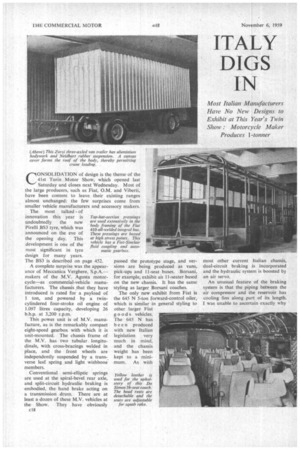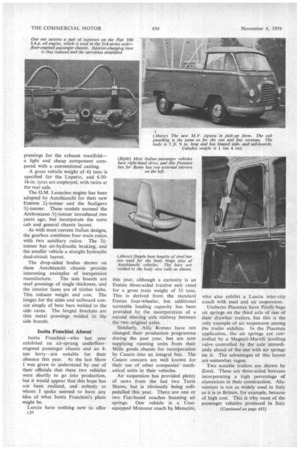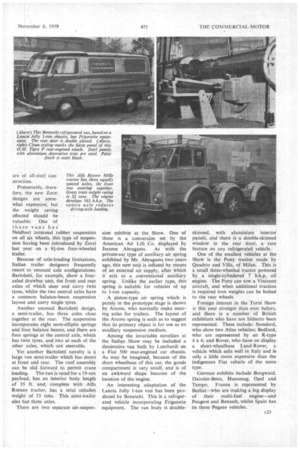ITALY DIGS IN
Page 56

Page 57

Page 58

Page 61

If you've noticed an error in this article please click here to report it so we can fix it.
Most Italian Manufacturers Have No New Designs to Exhibit at This Year's Twin Show : Motorcycle Maker Produces 1-tonner By John F. Moon,
A.M.I.R.T.E.
CONSOLIDATION of design is the theme of the 41st Turin Motor Show, which opened last Saturday and closes next Wednesday. Most of the large producers, such as Fiat, O.M. and Viherti, have been content to leave their existing ranges almost unchanged: the few surprises come from
smaller vehicle manufacturers and accessory makers. The most talked of innovation this year is undoubtedly the new Pirelli 13S3 tyre, which was announced on the eve of the opening day. This development is one of the most significant in tyre design for many years. The BS3 is described on page 452.
A complete surprise was the appearance of Meccanica Verghere, S.p.A.makers of the M.V. Agusta motorcycle—as commercial-vehicle manufacturers. The chassis that they have introduced is rated for a payload of 1 ton, and powered by a twincylindered four-stroke oil engine of 1.097 litres capacity, developing 26 b.h.p. at 3,200 r.p.m.
This power unit is of M.V. manufacture, as is the remarkably compact eight-speed gearbox with which it is unit-mounted. The chassis frame of the M.V. has two tubular longitudinals, with cross-bracings welded in place, and the front wheels are independently suspended by a transverse leaf spring and light wishbone members.
Top-hat-section pressings are used extensively in the body framing of the Fiat 410 all-welded integral bus. These pressings are boxed at high stress points. This vehicle has a Fiat-Sinclair fluid coupling and auto
matic. gearbox.
legislation very much in mind, and the chassis weight has been kept to a minimum. As with Conventional semi-elliptic springs are used at the spiral-bevel rear axle, and split-circuit hydraulic braking is embodied, the hand brake acting on a transmission drum. There are at least a dozen of these M.V. vehicles at the Show. They have obviously c18 passed the prototype stage, and versions are being produced as vans, pick-ups and II-seat buses. I3orsani, for example, exhibit an 11-seater based on the new chassis. It has the same styling as larger Borsani coaches.
The only new exhibit from Fiat is the 645 N 5-ton forward-control oiler, which is similar in general styling to other larger Fiat goods vehicles. The 645 N has been produced with new Italian most other current Italian chassis, dual-circuit brak ing is incorporated and the hydraulic system is boosted by an air servo.
An unusual feature of the braking system is that the piping between the air compressor and the reservoir has cooling fins along .part of its length. I was unable to ascertain exactly why this should be, but it is fairly safe to assume that the small compressor is working at a high .pressure. This would generate an undesirable amount of heat in the air system.
Other Fiat exhibits are as last year, but some interest is centred on the 410 integral bus, which is seen only partly assembled to show the framing. Most of the members are standard top-hat sections, boxed in highly stressed areas. Spot-welding is employed extensively in the frame assembly, and the exhibit had central steering, and a Fiat-Sinclair fluid coupling and four-speed automatic gearbox affording two-pedal control.
Possibly because of the death of Dr. Angelo Viberti earlier this year, Officine Viberti—who can normally be expected to provide several unusual exhibits—have little fresh to offer this year. The only vehicle of any note is a small dumper, based on a Fiat 642/T6 6-ton chassis, which is one of 400 being supplied to the Turkish Government.
One of the results of the agreement drawn up between Viberti and the Spanish Pegaso concern is to be seen in the outdoor park, where there is a Monotral bus with Pegaso running units. Power is supplied by a 120 b.h.p. oil engine driving through an eight-speed gearbox, and the normal Viberti Monotral all-steel welded construction is employed. A departure is the use of corrugated exterior panels which follow the styling of the standard Pegaso goods-vehicle cab. The Pegaso Monotral bus has an unladen weight of 7 tons and a gross weight rating of 10 tons, and its claimed maximum speed is 56 m.p.h. Two Pegaso goods vehicles are exhibited—rare appearances at an international motor show. One of these is powered by a V6 oil engine and the other by an in-line-six unit, both of which are of Pegaso manufacture.
The most striking exhibit shown by O.M. is the Lupetto 2-tonner, which was introduced earlier this year (The Commercial Motor, May 1, 1959). The Lupetto is unusual for a vehicle of this size in having an air-cooled oil engine which develops 56 b.h.p. at 2,200 r.p.m. This is derived from the 61 b.h.p. water-cooled unit used in the Leoncino 3-tonner.
The Lupetto engine—the CO1Khas cast-iron cylinder barrels and heads, and the fan is driven by twin V-belts from the front of the crankshaft. The air is ducted over the heads and barrels from the right of the engine, the metal ducting also shrouding an oil cooler. An unusual feature is the use of two butted metal pressings for the exhaust manifold— a light and cheap component compared with a conventional casting.
A gross vehicle weight of 41 tons is specified for the Lupetto, and 6.5016-in. tyres are employed, with twins at the rear axle.
The O.M. Leoneino engine has been adopted by Autobianchi for their new Estense 21-tonner and the Scaligero 31-tonner. These models succeed the Ambrosiano 3-1-4onner introduced two years ago, but incorporate the same cab and general chassis layout.
As with most current Italian designs, the gearbox combines four main ratios with two auxiliary ratios. The 31tonner has air-hydraulic braking, and the smaller vehicle a straight hydraulic dual-circuit layout.
The drop-sided bodies shown on these Autobianchi chassis provide interesting examples of inexpensive manufacture. The side boards are steel pressings of single thickness, and the interior faces are of timber laths. This reduces weight and cost, The hinges for the sides and tailboard consist simply of bent bars welded to the side raves. The hinged brackets are thin metal pressings welded to the side boards.
Isotta Fraschini Absent
Isotta Fraschini—who last year exhibited an air-sprung underfloorengined passenger chassis and an 8ton lorry—are notable for their absence this year. At the last Show I was given to understand by one of their officials that these two vehicles were shortly to go into production, but it would appear that this hope has not been realized, and nobody to whom I spoke seemed to have any idea of what Isotta Fraschini's plans might be.
Lancia have nothing new to offer c2n this year, although a curiosity is an Esatau three-axled tractive unit rated for a gross train weight of 32 tons. This is derived from the standard Esatau four-wheeler, but additional turntable loading capacity has been provided by the incorporation of a second steering axle midway between the two original axles.
Similarly, Alfa Romeo have not changed their production programme during the past year, but are now supplying running units from their Male goods chassis for incorporation by Casaro into an integral bus. The Casaro concern are well known for their use of other companies' mechanical units in their vehicles.
Air suspension has provided plenty of news from the last, two Turin Shows, but is obviously being softpedalled this year. There are one or two Fiat-based coaches boasting air springs. One vehicle is a Ceatequipped Monocar coach by Menarini, who also exhibit a Lancia inter-city coach with steel and air suspension.
Umberto Piacenza have Pirelli-Saga air springs on the third axle of One of their drawbar trailers, but this is the only example of air suspension among the trailer exhibits. In the Piacenza application, the air springs are controlled by a Magneti-Marelli levelling valve controlled by the axle immediately ahead of the One with air springs on it. The advantages of this layout are somewhat vague.
Two notable trailers are shown by Zorzi. These are three-axled boxvans incorporating a high percentage of aluminium in their construction. Aluminium is not as widely used in Italy as it is in Britain, for example, because of high cost. This is why most of the passenger vehicles produced in Italy are of all-steel construction.
driving-axle loading.
Presumably, therefore, the new Zorzi designs are somewhat expensive, but the weight saving effected should be valuable. One of these vans has Neid hart torsional rubber suspension on all six wheels, this type of suspension having been introduced by Zorzi last year on a 91-ton four-wheeled trailer. • • Because of axle-loading limitations, Italian trailer designers frequently resort to unusual axle configurations. Bartoletti, for example, show a fouraxled drawbar unit, the front and rear axles of which steer and carry twin tyres, whilst the two central axles have a common balance-beam suspension layout and carry single tyres.
Another unusual Bartoletti design, a semi-trailer, has three axles close together at the rear. The suspension incorporates eight semi-elliptic springs and four balance beams, and there are four springs at the central axle, which has twin tyres, and two at each of the other axles, which are steerable.
Yet another Bartoletti novelty is a large van semi-trailer which has doors at front and rear. The roof assembly can be slid forward to permit crane loading. The van is rated for a 19-ton payload, has an interior body length of 35 ft. and, complete with Alfa Romeo tractor, has a total unladen weight of 13 tons. This semi-trailer also has three axles.
There are two separate air-suspen sion exhibits at the Show. One of these is a conversion set by the American Air Lift Co. displayed by Jerome Abragams. As with the private-car type of auxiliary air spring exhibited by Mr. Abragarns two years ago, this new unit is inflated by means of an external air supply, after which it ads as a conventional auxiliary spring. Unlike the earlier type, this spring is suitable for vehicles of up to 1-ton capacity.
A piston-type air spring which is purely in the prototype stage is shown by Arcom, who normally make steering axles for trailers. The layout of the Arcom spring is such as to suggest that its primary object is for use as an auxiliary suspension medium.
Among the invariable novelties at the Italian Show may be included a diminutive van built by Lombardi on a Fiat 500 rear-engined car chassis. As may be imagined, because of the short wheelbase of this car, the goods compartment is very small, and is of an awkward shape because of the location of the engine.
An interesting adaptation of the Lancia Jolly 1-ton van has been produced by Boneschi. This is a refrigerated vehicle incorporating Frigorette equipment. The van body is double skinned, with aluminium interior panels, and there is a double-skinned window in the rear door, a rare feature on any refrigerated vehicle.
One of the smallest vehicles at the Show is the Pony tractor made by Quadrio and Villa, of Milan. This is a small three-wheeled tractor powered by a single-cylindered 7 blip. oil engine. The Pony can tow a Viscount aircraft, and when additional traction is required iron weights can be bolted to the rear wheels.
Foreign interest in the Turin Show is this year stronger than ever before, and there is a • number of British exhibitors who have not hitherto been represented. These include: Standard, who show two Atlas vehicles; Bedford, who are represented by an R-type 4 x 4; and Rover, who have on display a short-wheelbase Land-Rover, a vehicle which sells well in Italy and is only a little more expensive than the indigenous Fiat vehicle of the same type.
German exhibits include Borgward, Daimler-Benz, Hanomag, Opel and Tempo. France is represented by Berliet—who are making a big display of their multi-fuel engine—and Peugeot and Renault, whilst Spain has its three Pegaso vehicles,












































































































